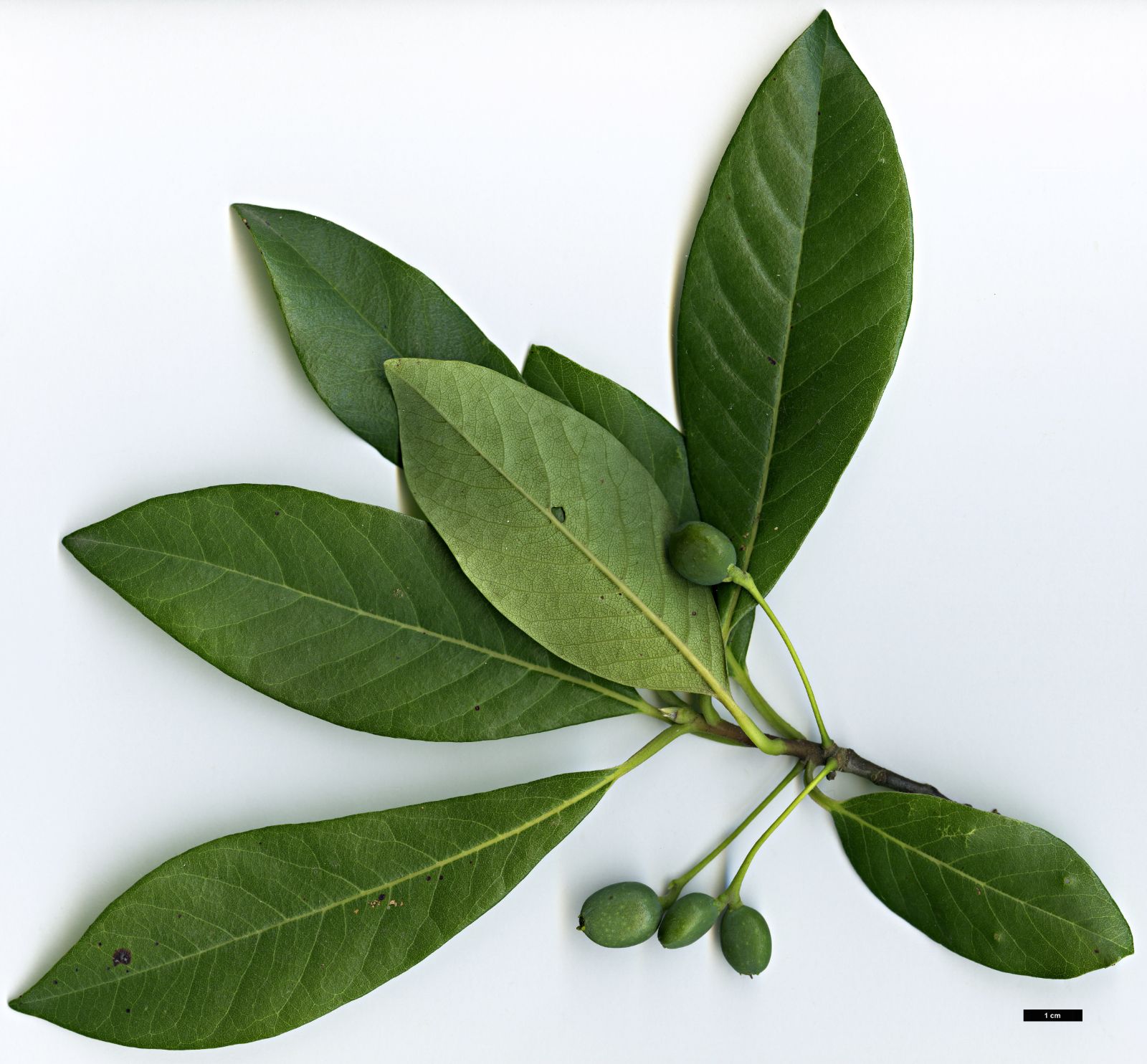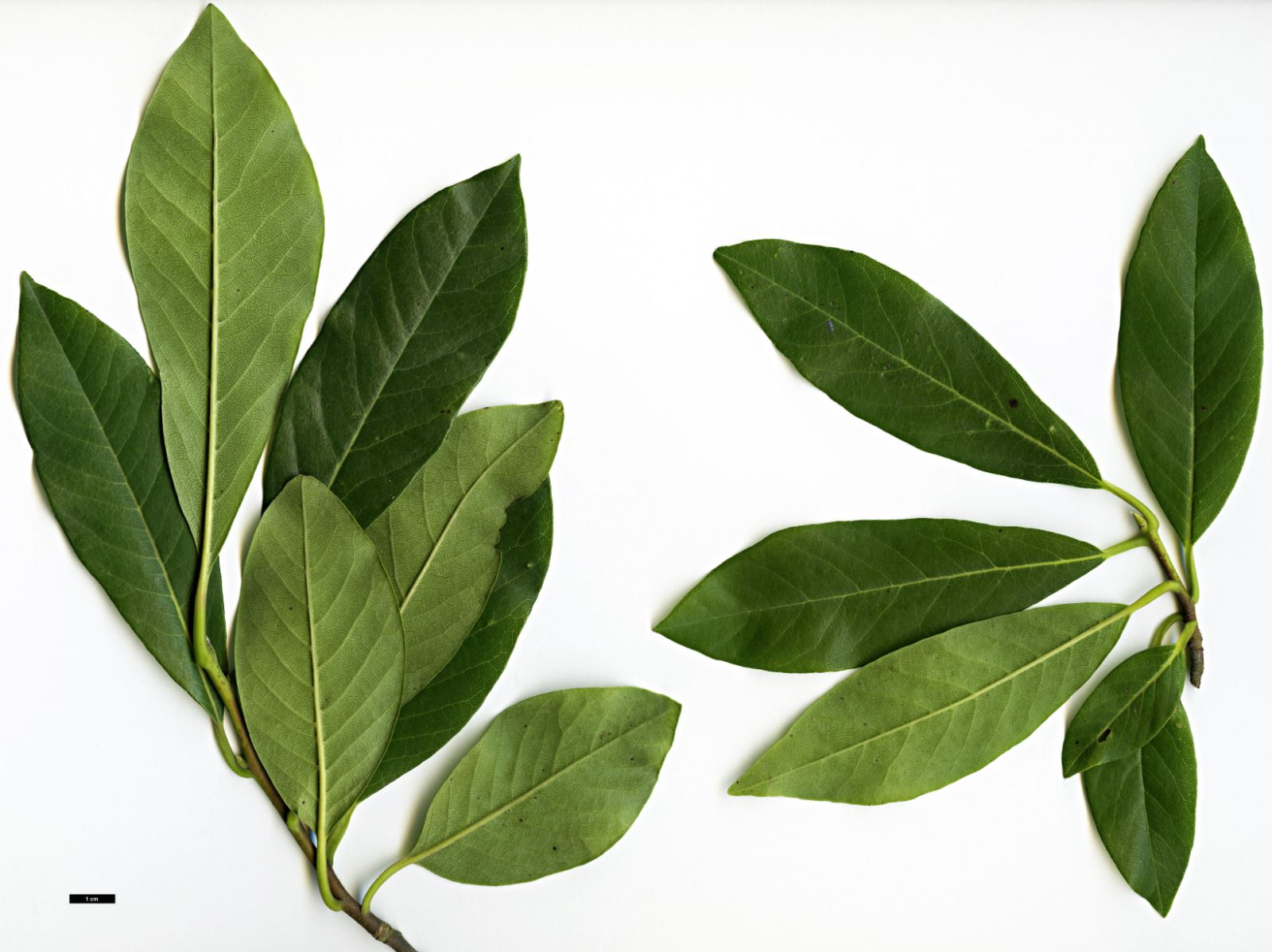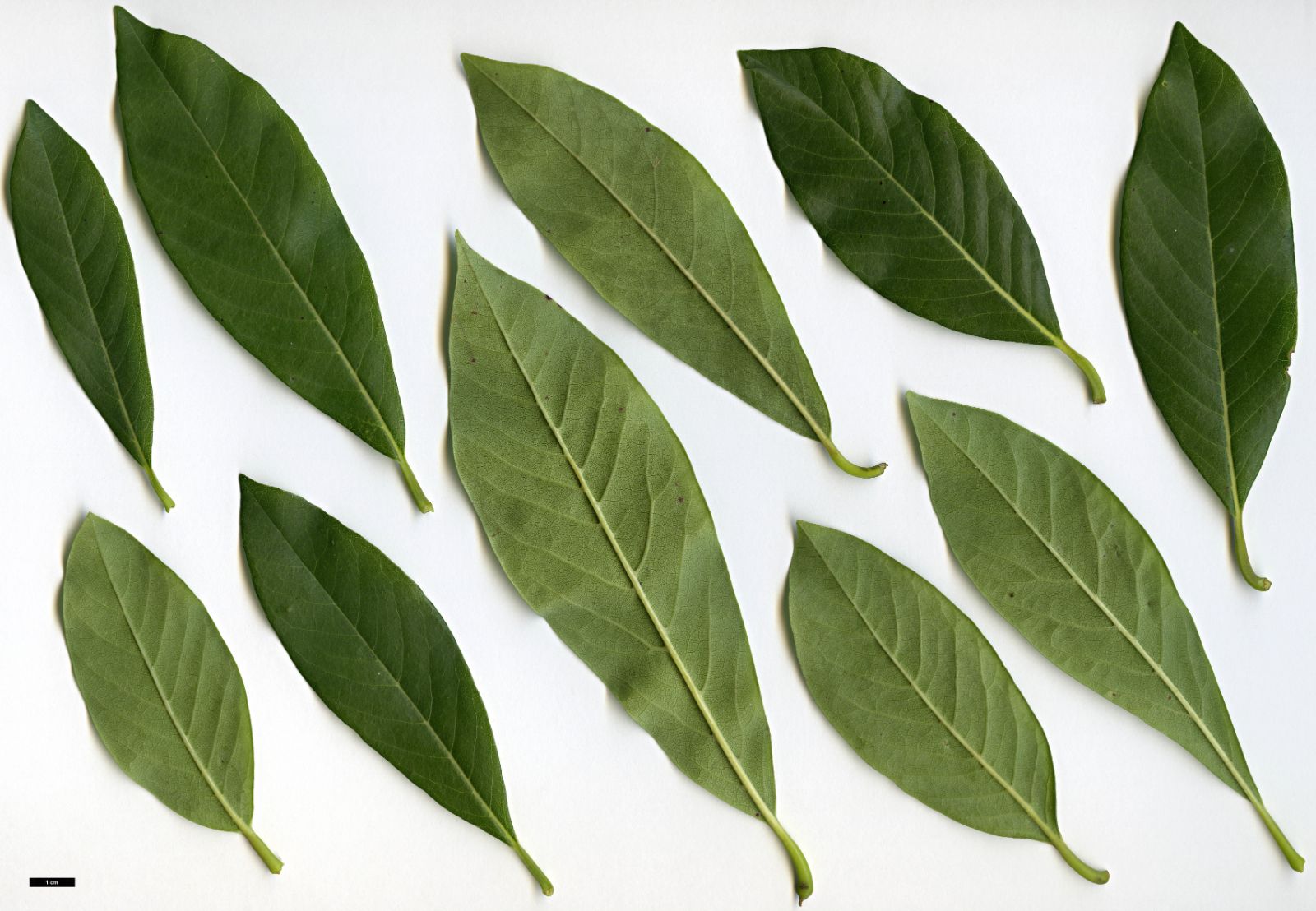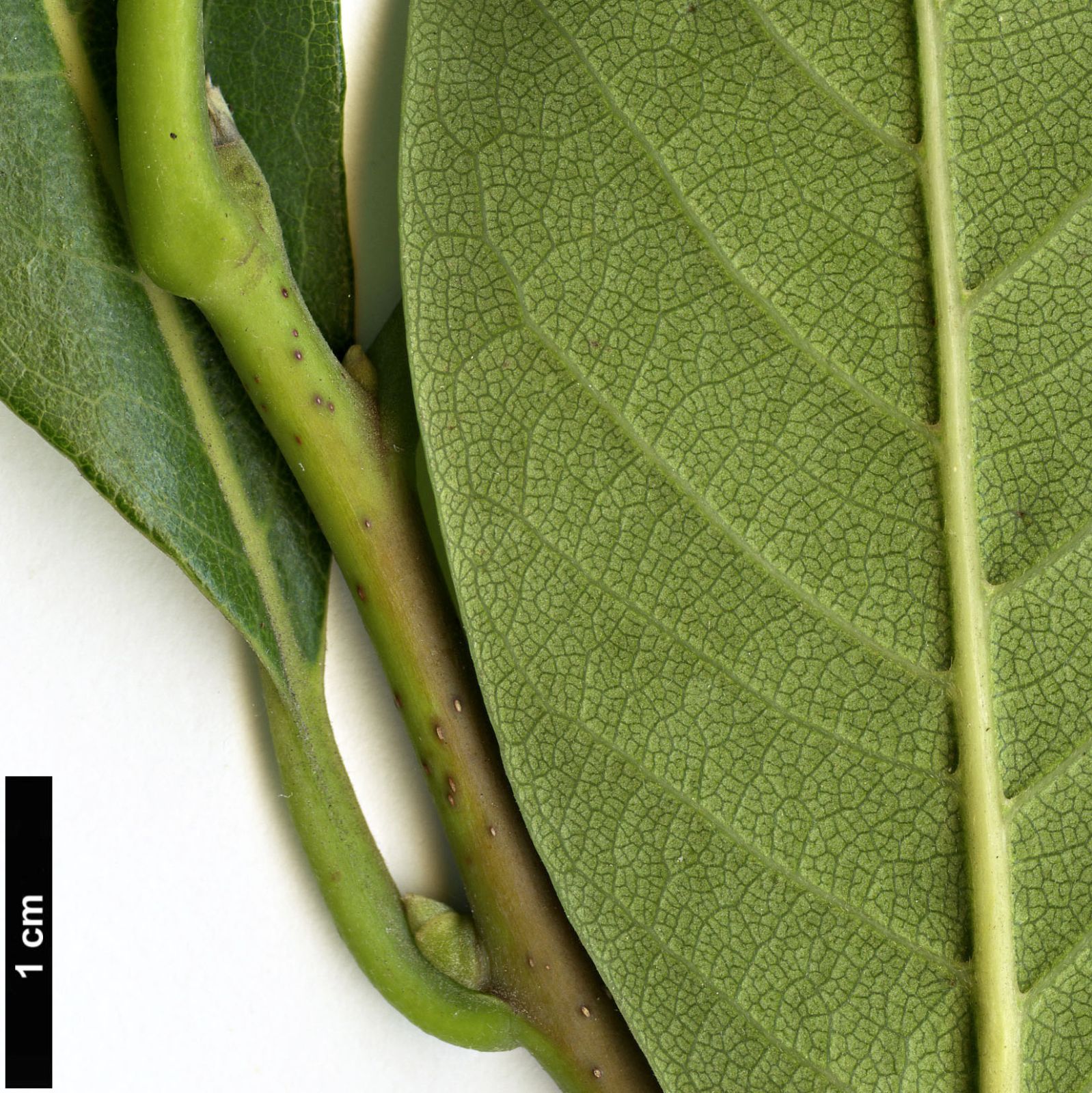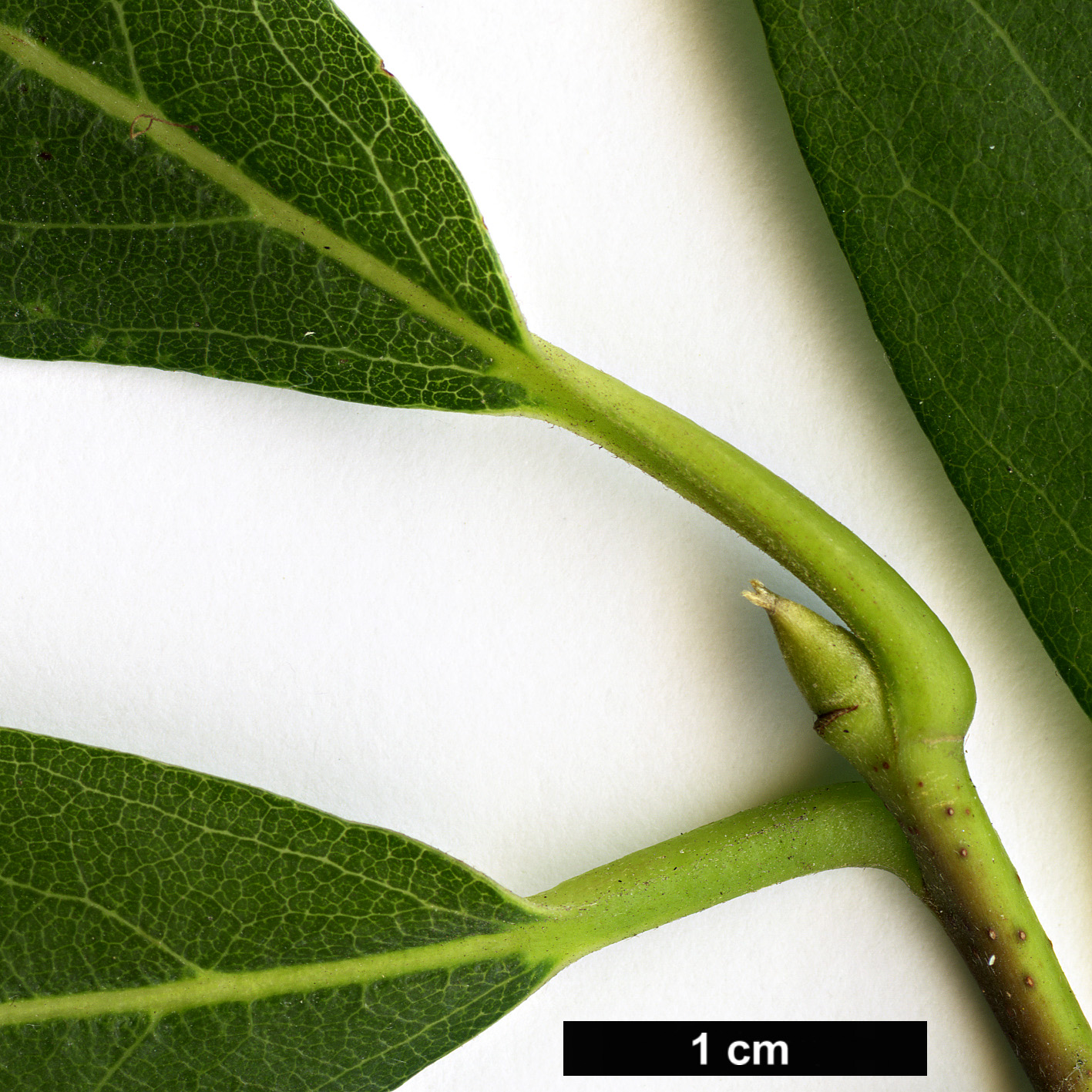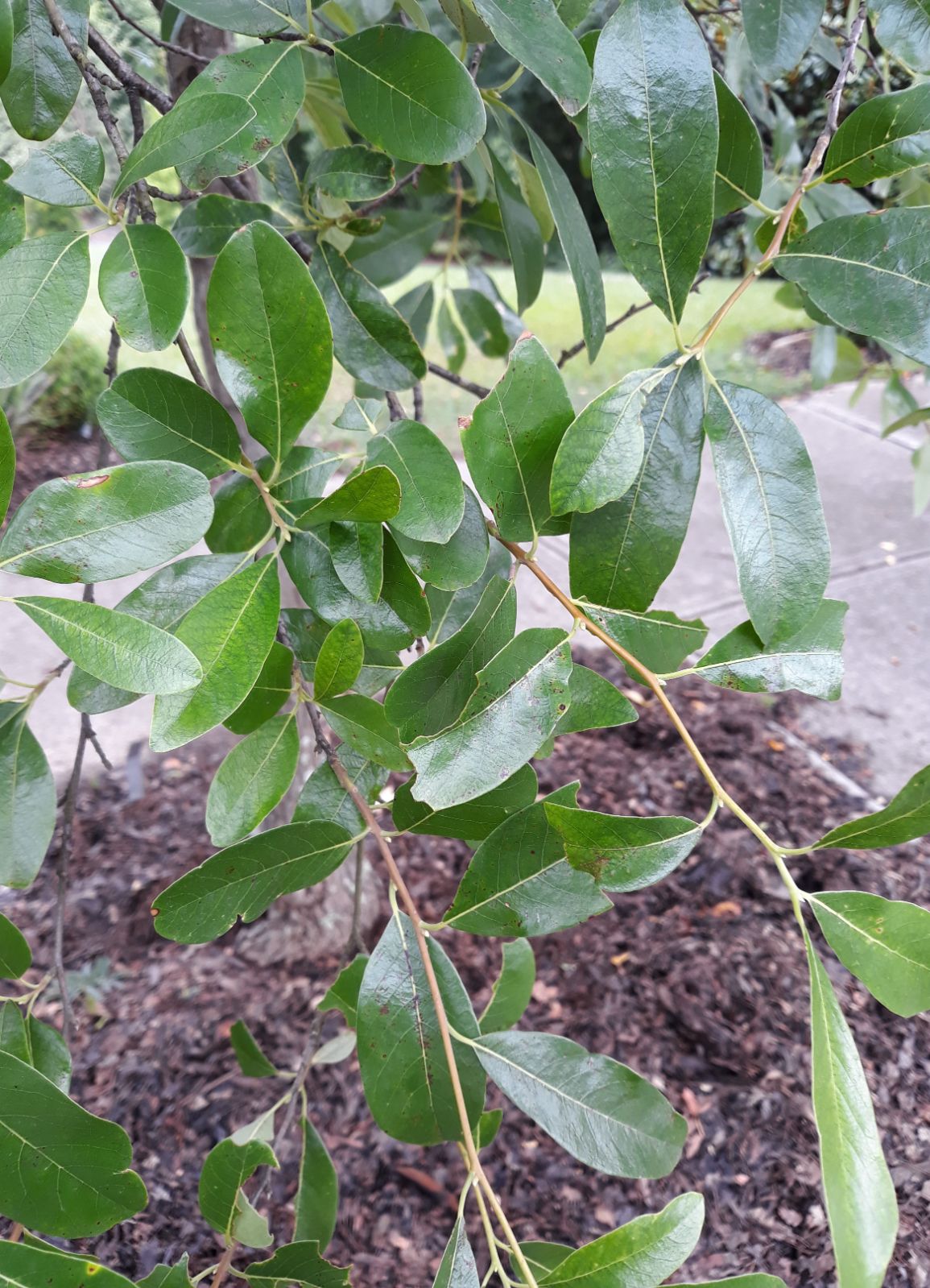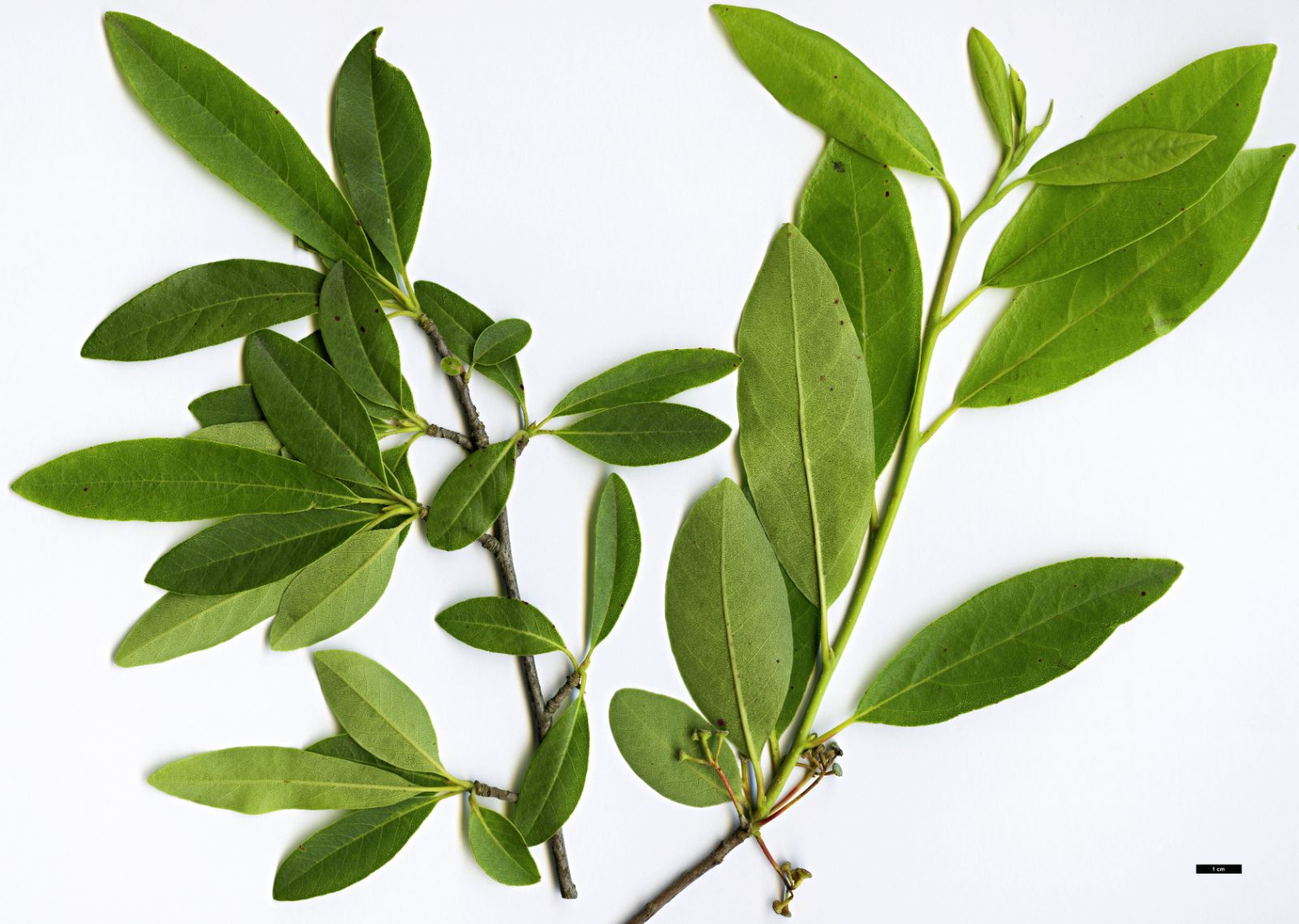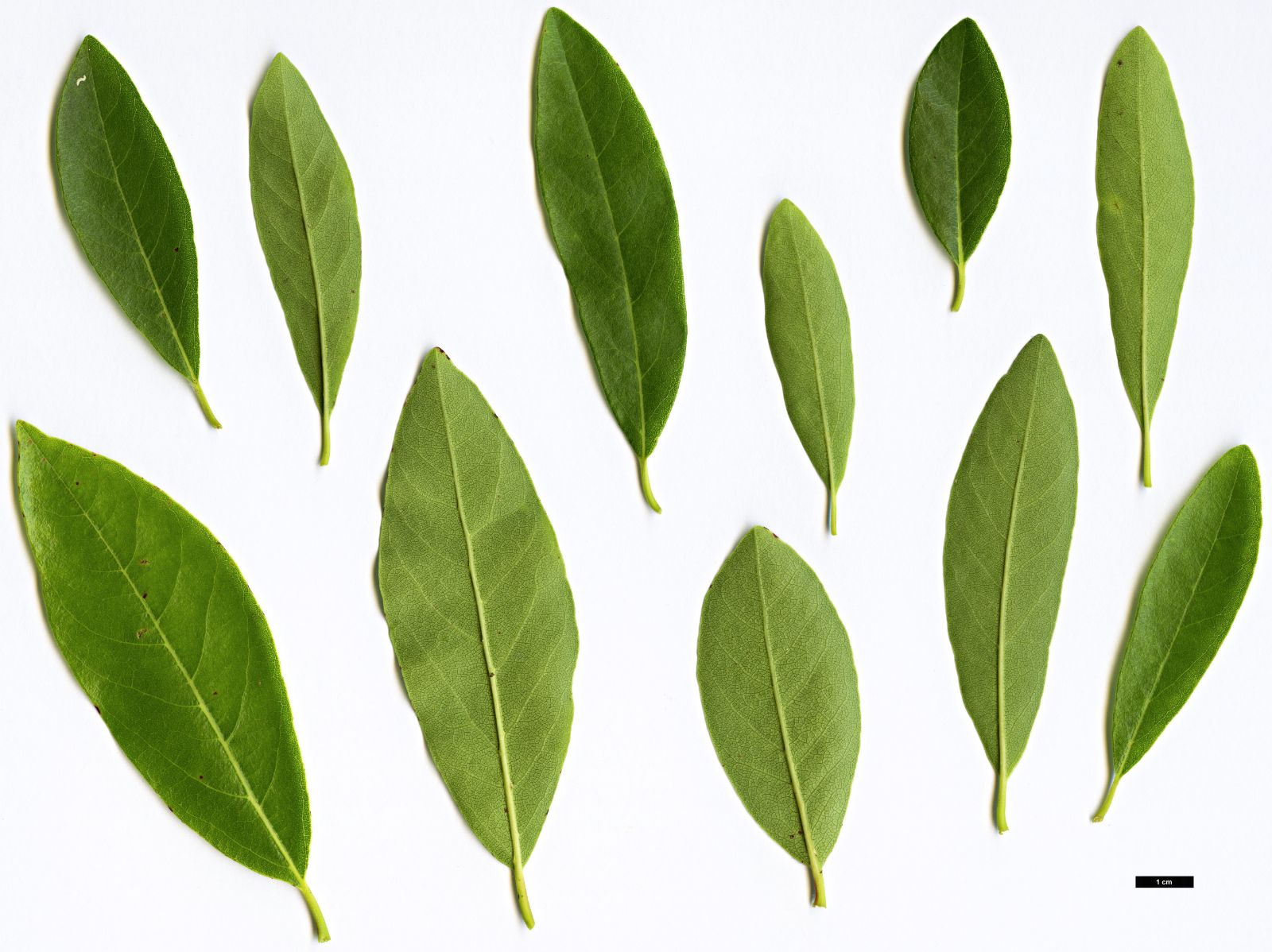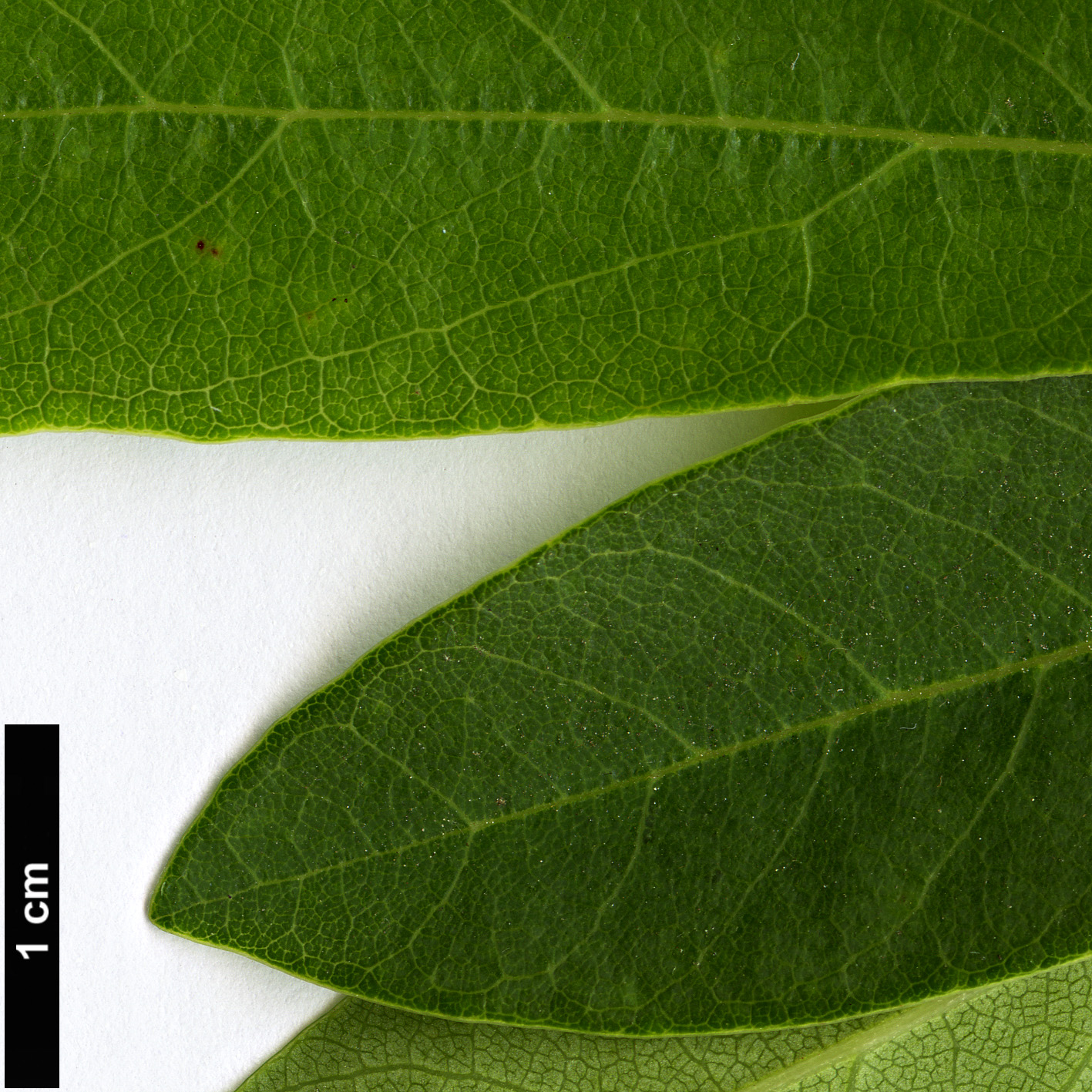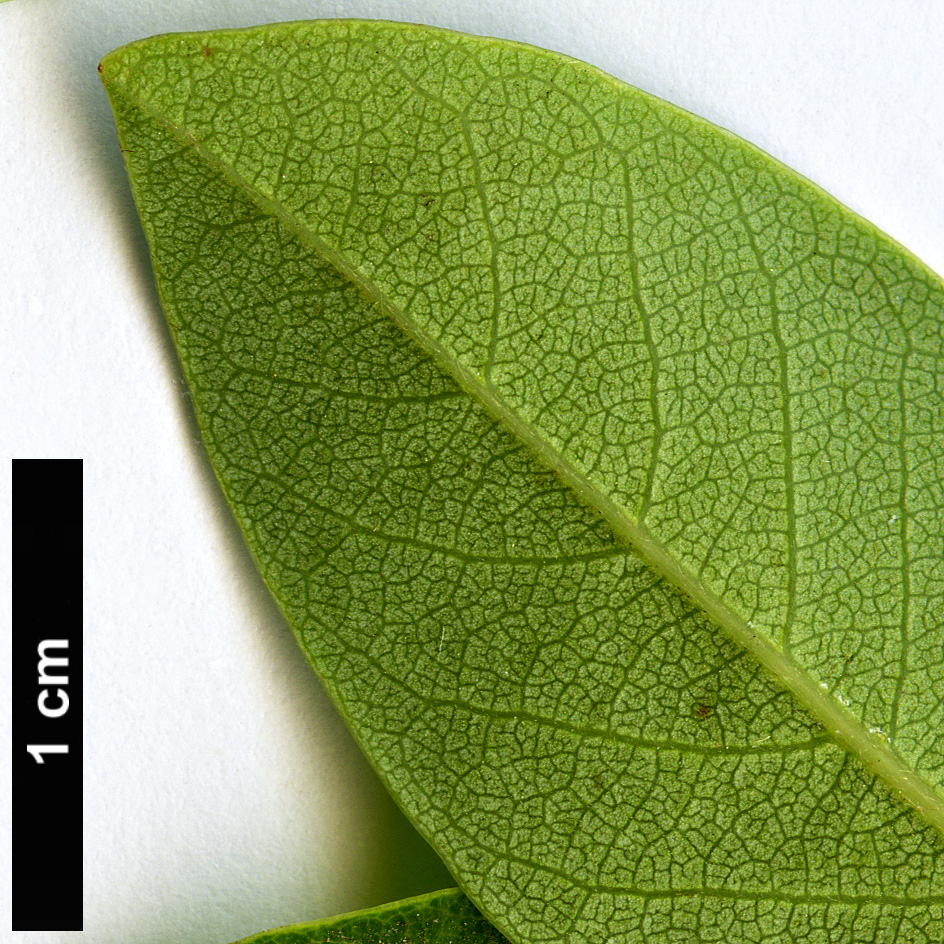Nyssa biflora
Sponsor
Kindly sponsored by a member of the International Dendrology Society.
Credits
Owen Johnson (2021)
Recommended citation
Johnson, O. (2021), 'Nyssa biflora' from the website Trees and Shrubs Online (treesandshrubsonline.
Genus
Common Names
- Swamp Black Gum
- Swamp Sour Gum
- Mountain Tupelo
Synonyms
- Nyssa sylvatica subsp. biflora (Walter) A.E. Murray
- Nyssa sylvatica var. biflora (Walter) Sargent
Infraspecifics
Other taxa in genus
Tree to 35 m, often with a straight trunk conspicuously flared or bottle-shaped at the base; crown irregular. Bark grey brown, soon deeply but not regularly fissured. Twigs grey brown, glabrous or puberulent; terminal bud long (to 1 cm), reddish, conic and sharp. Leaves slender, 3.7–7.2 × 1.6– 3.5 cm, rather leathery; base cuneate to rounded, apex often obtuse, sometimes acute, margin entire or rarely with a few big teeth towards the tip; glabrous above and slightly glossy; paler beneath and sometimes puberulent near the veins; petiole very short (7–10 mm). Inflorescences on long (3.2–5.5 cm), sparsely hairy peduncles; male inflorescences with 2–8 flowers (rarely 1), female and bisexual inflorescences with 1–3 (typically 2) flowers. Staminate pedicels present. Ovary glabrous. Fruit black or dark bluish, glaucous, smooth, flattened ovoid, small (7–14 mm long); stone 7–9 mm long, with several low and rounded longitudinal ridges. (Flora of North America 2021).
Distribution United States Alabama, Arkansas, Delaware, Florida, Georgia, Illinois, Kentucky, Louisiana, Maryland, Mississippi, Missouri, New Jersey, North Carolina, South Carolina, Tennessee, Texas, Virginia
Habitat Ponds, streamsides and wet slopes, sometimes in drier forests, mostly below 100 m asl.
USDA Hardiness Zone 6a
RHS Hardiness Rating H6
Conservation status Not evaluated (NE)
Nyssa biflora is barely known as a garden tree, even in its native United States, and many botanists have viewed it as a minor variant of the commoner N. sylvatica, with some specialist adaptations to wetter ground. Recent phylogenetic analysis by Wenbin Zhou et al. (Zhou et al. 2018), however, has shown that, although N. biflora is more closely related to N. sylvatica than to the two large-fruited wetland species (N. aquatica and N. ogechee), its ancestors have probably remained distinct from those of N. sylvatica for 11–13 million years, thoroughly justifying the elevation of N. biflora to species status.
Nyssa biflora is best told from N. sylvatica by its slightly narrower and more leathery leaves and its rather flat berries (Exbury Garden 2021), by its less regularly fissured bark and by the tendency of the female flowers to be held in pairs rather than groups of three or more. Old trees in flooded land also show the flared base of the trunk that is a characteristic more fully expressed in N. aquatica and N. ogechee, though perhaps of less use in cultivation. Out of fruit, the short leaf stalk and the long, pointed buds are the best features distinguishing N. biflora from the latter species.
This relatively obscure species has probably always been extremely rare in cultivation in Europe, though gardeners and botanists may have failed to differentiate it from N. sylvatica; as a plant from low-lying, warm places, it is likely to be poorly adapted to the cool, short summers of the United Kingdom and Ireland, and adjacent areas of north western Europe. This said, the current champion, growing in acidic woodland conditions near Brentry House in the Sir Harold Hillier Gardens in Hampshire, is a respectable tree, 14 m × 40 cm dbh in 2017 (Tree Register 2021). In Maurice Foster’s arboretum at White House Farm in Kent, in free-draining sandstone at 150 m asl, a younger plant had grown vigorously to 8 m in 2020 (Tree Register 2021), and there is another young example considerably further north, at John Ravenscroft’s Cherry Tree Arboretum in Shropshire (Tree Register 2021). The species is now sold in the United Kingdom by both Bluebell and Mallet Court nurseries, and by Southern Woods in New Zealand, where it ought to be successful.
subsp. ursina (Small) Q.Y. Xiang, W.B. Zhou & R. Peet
Common Names
Bear Tupelo
Apalachicola Tupelo
Dwarf Tupelo
Synonyms
Nyssa biflora var. ursina (Small) D.B. Ward
Nyssa sylvatica var. ursina (Small) J. Wen & Stuessy
Nyssa ursina Small
A shrub or a small tree to c. 5 m tall; crown usually intricately branched; bole buttressed at the base. Bark grey brown, soon developing relatively deep but irregular fissures. Twigs usually glabrous; buds reddish, long-pointed. Leaves 2–5(–7) × 1–2 cm, rather leathery; base cuneate to rounded, apex obtuse; margins entire; petiole very short (4–9 mm). Inflorescences on long (3.2–5.5 cm) peduncles, sparsely hairy or glabrous; male inflorescence with 2–5 flowers (rarely 1), female and bisexual inflorescences in pairs or sometimes singly. Staminate pedicels present. Ovary glabrous. Fruit black or dark bluish, glaucous, smooth, globose, 7–11 mm; stone 6–8 mm, with low, rounded longitudinal ridges. (Flora of North America 2021).
Distribution
- United States – Florida; in six counties in the panhandle region.
RHS Hardiness Rating: H5
USDA Hardiness Zone: 7
Bear Tupelo was first described (as a species) in 1927 by John Kunkel Small and, since then, has led a rather vagrant existence, most often described as a variant of either N. sylvatica or N. biflora. In 2018, phylogenetic research by Wenbin Zhou et al. (Zhou et al. 2018) clearly placed it in the latter camp; it shows many genetic variances from N. sylvatica but is not readily distinguishable from N. biflora, suggesting that its shrubby habit and proportionately diminutive leaves and fruit are recent adaptations, best reflected by the rank of subspecies. Nyssa biflora subsp. biflora is also present across the tiny natural range of subsp. ursina, but the two forms seem not to interbreed (Flora of North America 2021); subsp. ursina grows in slightly drier places that are prone to fire. These are also the characteristic habitat of the endemic Florida Black Bear (Ursus americanus floridanus), after which this tree is named.
Where it does occur, Bear Tupelo is often common (NatureServe 2021), but it is considered a plant of conservation concern (Flora of North America 2021). Despite its vulnerably tiny range, it is scarcely seen in botanical institutions in the rest of the world and it remains practically unknown as a garden tree closer to home. At the J.C. Raulston Arboretum in North Carolina, one planted in 2002 beside the car park has made a more vigorous and open-branched plant than is typical in the wild (Grimshaw & Bayton 2009). In the United Kingdom’s National Collection of Nyssa at Exbury in Hampshire, its autumn colour is brilliant (Exbury Garden 2021), although, like most of the other American Nyssa, it presumably likes more summer heat than northern Europe is likely to provide and may, in addition, be less hardy than its allies. Nevertheless, its naturally compact habit does suggest that the Bear Tupelo could yet have a minor role to play as a garden tree.


